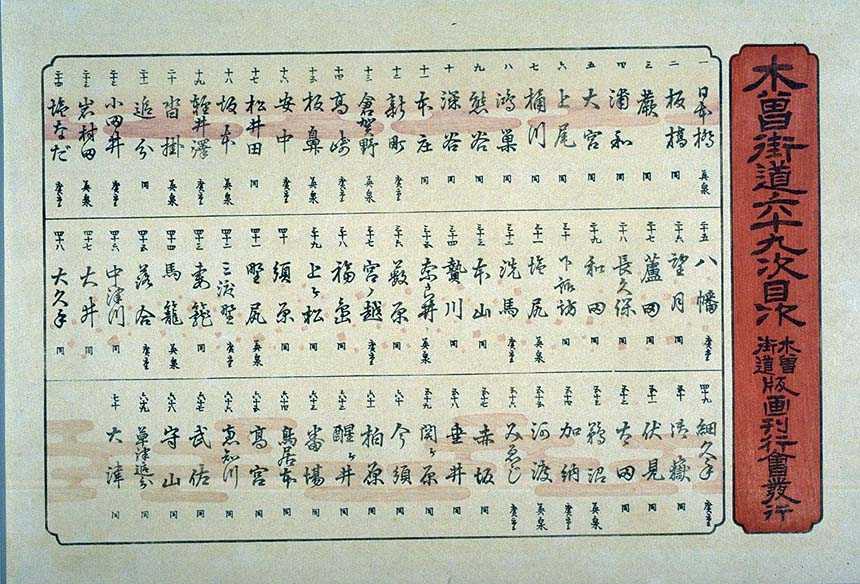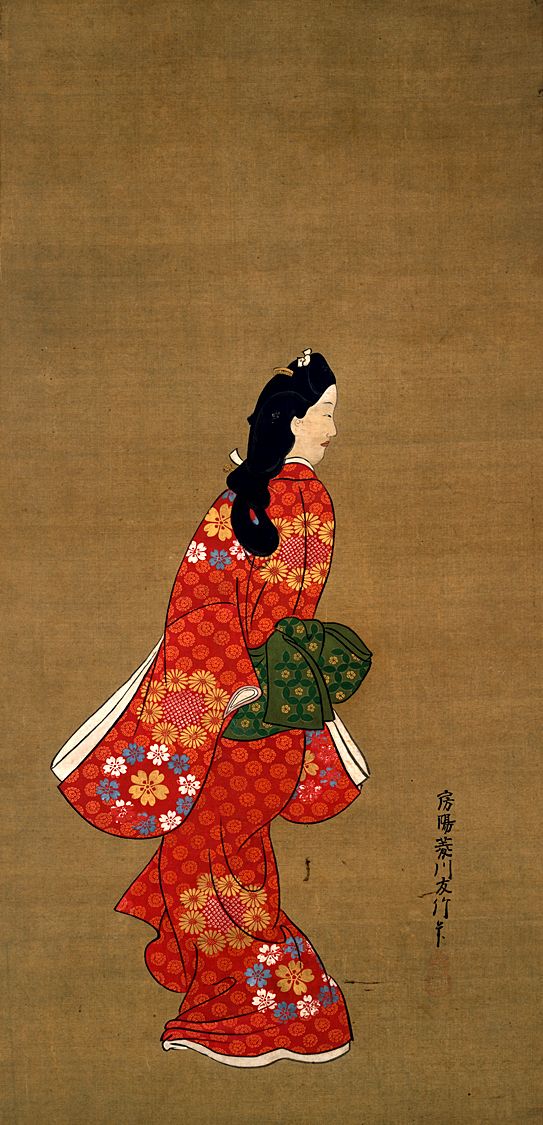|
ĹŚta-juku
was the fifty-first of the 69 Stations of the NakasendĹŤ, sixty-nine stations of the NakasendĹŤ connecting Edo with Kyoto in Edo period Japan. It is located in former Mino Province in what is now part of the city of Minokamo, Gifu, Minokamo, Gifu Prefecture, Japan.NakasendĹŤ no ĹŚta-juku NakasendĹŤ Museum OOTAJUKU.NET. Accessed June 5, 2008. History ĹŚta is located at the confluence of the Kiso River and the Hida River, and the river crossing at this location was considered the most difficult on the NakasendĹŤ. During the spring thaw, flooding was common, and the Hida River could be enlarged to over 700 meters in width. This rendered communications difficult, and travelers could be stranded at ĹŚta-juku potentially for days waiting for the waters to be calm enough to cross. ĹŚta also within the territo ...[...More Info...] [...Related Items...] OR: [Wikipedia] [Google] [Baidu] |
ĹŚta-juku NakasendĹŤ Museum
is a museum dedicated to the history and culture of the NakasendĹŤ's ĹŚta-juku and is located in the city of Minokamo, Gifu, Minokamo, Gifu Prefecture, Japan.NakasendĹŤ no ĹŚta-juku NakasendĹŤ Museum OOTAJUKU.NET. Accessed June 5, 2008. Exhibits The main focus of the exhibit is on the history and culture of ĹŚta-juku, one of the NakasendĹŤ's ''shukuba''. The displays include pieces related to Kazu-no-Miya Chikako who stayed at the ''shukuba'' while traveling the NakasendĹŤ. Part of the museum was built using materials from the house of , a famous artist who resided in the area from 1946 until his death two years later. This structure is separate from the main building and is a replica of Okamoto's completed house.Facilities information *Hours ...[...More Info...] [...Related Items...] OR: [Wikipedia] [Google] [Baidu] |
The Sixty-nine Stations Of The Kiso KaidĹŤ
The or ''Sixty-nine Stations of the Kiso Road'', is a series of ''ukiyo-e'' works created by Utagawa Hiroshige and Keisai Eisen. There are 71 total prints in the series (one for each of the 69 shukuba, post stations and Nihonbashi; Nakatsugawa-juku has two prints). The common name for the KisokaidĹŤ is "NakasendĹŤ" so the series is sometimes referred to as the ''Sixty-nine Stations of the NakasendĹŤ''. It is a follow-up to Hiroshige's ''The Fifty-three Stations of the TĹŤkaidĹŤ'' and he produced 47 of the prints, with Eisen being responsible for the rest.Hiroshige - Kisokaido www.hiroshige.org.uk. Accessed November 1, 2017. The series was published by Iseya Rihei (KinjudĹŤ) from .Forrer The NakasendĹŤ The NakasendĹŤ was one of the Edo Five Routes, Five Routes con ...[...More Info...] [...Related Items...] OR: [Wikipedia] [Google] [Baidu] |
Minokamo, Gifu
is a city located in Gifu, Japan. , the city had an estimated population of 56,972 and a population density of 74.81 persons per km2, in 22,508 households. The total area of the city was . Geography Minokamo is located in south-central Gifu Prefecture in the Nōbi Plain, between the Hida Mountains and the Kiso River. Neighbouring municipalities *Gifu Prefecture ** Hichisō ** Kani ** Kawabe ** Mitake ** Sakahogi ** Seki ** Tomika ** Yaotsu Climate The city has a climate characterized by hot and humid summers, and mild winters (Köppen climate classification ''Cfa''). The average annual temperature in Minokamo is . The average annual rainfall is with July as the wettest month. The temperatures are highest on average in August, at around , and lowest in January, at around . Demographics Per Japanese census data, the population of Minokamo has grown substantially over the past 50 years. Notably, the proportion of foreign nationals residing in the city is very high for Japan ... [...More Info...] [...Related Items...] OR: [Wikipedia] [Google] [Baidu] |
Unuma-juku
was the fifty-second of the sixty-nine stations of the NakasendĹŤ connecting Edo with Kyoto in Edo period Japan. It is located in former Mino Province in what is now part of the city of Kakamigahara, Gifu Prefecture, Japan.Unuma-juku Juunin Homepage Unuma-juku Juunin. Accessed July 10, 2007. History Unuma was an important junction linking the routes that connected the provinces of Mino and Owari. It is of ancient origin, having been a stop on the old road, that predated the creation of the NakasendĹŤ. It was also the last post station on the[...More Info...] [...Related Items...] OR: [Wikipedia] [Google] [Baidu] |
Fushimi-juku (NakasendĹŤ)
270px, Monument marking the site of the ''honjin'' of Fushimi-juku was the fiftieth of the sixty-nine stations of the NakasendĹŤ connecting Edo with Kyoto in Edo period Japan. It is located in former Mino Province in what is now part of the town of Mitake, Kani District, Gifu Prefecture, JapanNakasendo Fushimi-juku . Ibisoku Co., Ltd. Accessed July 11, 2007. History In the early , the system of post stations on the NakasendĹŤ was formalized by the |
Honjin
image:Ohara-juku01s3200.jpg, The ''honjin'' at Inaba KaidĹŤ's ĹŚhara-shuku. is the Japanese word for an inn for government officials, generally located in post stations (''shukuba'') during the later part of the Edo period. Evolution of ''Honjin'' Originally, ''honjin'' were places from which generals directed battles and, therefore, were fleeting in nature. However, as commanders began to transform the ''honjin'' into temporary lodgings during battle and travel, ''honjin'' came to be places where ''daimyĹŤ'' and other representatives of the shogunate, including ''hatamoto'', ''monzeki'', etc., were allowed to stay during their travels. Many of the ''honjin'' were actually personal residences of village and town leaders. As such, they received official designations from the government and expanded their residences to include walls, gates and other features. Because of their cooperation, the owners of the ''honjin'' also gained various special rights. General travelers, regardless ... [...More Info...] [...Related Items...] OR: [Wikipedia] [Google] [Baidu] |
Shukuba
were Stage station, staging post stations during the Edo period in Japan, generally located on one of the Edo Five Routes or one of its sub-routes. They were also called ''shuku-eki'' (宿駅). These stage stations, or "" developed around them, were places where travelers could rest on their journey around the nation. They were created based on policies for the transportation of goods by horseback that were developed during the Nara period, Nara and Heian period, Heian periods. History These stations were first established by Tokugawa Ieyasu shortly after the end of the Battle of Sekigahara. The first stations were developed along the Tōkaidō (road), Tōkaidō (followed by stations on the Nakasendō and other routes). In 1601, the first of the Tōkaidō's 53 Stations of the Tōkaidō, fifty-three stations were developed, stretching from Shinagawa-juku in Edo to Ōtsu-juku in Ōmi Province. Not all the post stations were built at the same time, however, as the last one was bui ... [...More Info...] [...Related Items...] OR: [Wikipedia] [Google] [Baidu] |
Princess Kazu
(''Kazunomiya'') was the wife of 14th ''shōgun'' Tokugawa Iemochi. She was renamed Lady Seikan'in-no-miya after she took the tonsure as a widow. Chikako was the youngest child of Emperor Ninkō. Biography Her birth name was Chikako. She was the eighth and youngest daughter of Emperor Ninkō, and was renamed Kangyō'in (観行院) by his concubine, Hashimoto Tsuneko , after she took the tonsure. She was the younger half-sister of Emperor Kōmei.Nussbaum, Louis-Frédéric ''et al.'' (2005). ''Japan encyclopedia'', p. 502; n.b., Louis-Frédéric is pseudonym of Louis-Frédéric Nussbaum, ''see'Deutsche Nationalbibliothek Authority File A few months before her birth, her father, Emperor Ninkō, died unexpectedly. Born on 1 August 1846, her official birth date was changed to 10 May because the actual birth date was a bad omen date, and a double bad omen with the death of her father a few months before. She was known as an excellent calligrapher and she was also highly regard ... [...More Info...] [...Related Items...] OR: [Wikipedia] [Google] [Baidu] |
Stations Of The NakasendĹŤ
Station may refer to: Agriculture * Station (Australian agriculture), a large Australian landholding used for livestock production * Station (New Zealand agriculture), a large New Zealand farm used for grazing by sheep and cattle ** Cattle station, a cattle-rearing station in Australia or New Zealand **Sheep station, a sheep-rearing station in Australia or New Zealand Communications * Radio communication station, a radio frequency communication station of any kind, including audio, TV, and non-broadcast uses ** Radio broadcasting station, an audio station intended for reception by the general public ** Amateur radio station, a station operating on frequencies allocated for ham or other non-commercial use ** Broadcast relay station ** Ground station (or Earth station), a terrestrial radio station for extraplanetary telecommunication with satellites or spacecraft ** Television station * Courier station, a relay station in a courier system ** Station of the ''cursus publicus'', a s ... [...More Info...] [...Related Items...] OR: [Wikipedia] [Google] [Baidu] |
NikkĹŤ Reiheishi KaidĹŤ
The was established during the Edo period as a subroute to NikkĹŤ KaidĹŤ. It connected the NakasendĹŤ with the NikkĹŤ KaidĹŤ.NikkĹŤ ReiheishidĹŤ . Mainichi Shinbun. Accessed August 29, 2007. . City of Takasaki. Accessed August 29, 2007. Stations of the NikkĹŤ Reiheishi KaidĹŤ The 21 post stations of the NikkĹŤ Reiheishi KaidĹŤ, with their present-day municipalities listed beside them.# |
Hida Province
was a province of Japan in the area that is today the northern portion of Gifu Prefecture in the ChĹ«bu region of Japan. Nussbaum, Louis-FrĂ©dĂ©ric. (2005). "''Wakasa''" in . Hida bordered on Echizen, Mino, Shinano, EtchĹ«, and Kaga Provinces. It was part of TĹŤsandĹŤ Circuit. Its abbreviated name was . Under the '' Engishiki'' classification system, Hida was ranked as an "inferior country" (下国) and a middle country (ä¸ĺ›˝) in terms of its importance and distance from the capital. Currently, the entire area of the former Hida Province consists of the cities of Hida, Takayama and most of the city of Gero, and the village of Shirakawa, in ĹŚno District . Overview "Hida" indicates the west side of the Hida Mountains. The climate is similar to that of the provinces of the Sea of Japan, with extremely heavy snow in winter. Hida traditionally had strong economic and cultural ties with the neighboring EtchĹ« Province due to the ease of transportation and poor conne ... [...More Info...] [...Related Items...] OR: [Wikipedia] [Google] [Baidu] |
Ukiyo-e
is a genre of Japanese art that flourished from the 17th through 19th centuries. Its artists produced woodblock printing, woodblock prints and Nikuhitsu-ga, paintings of such subjects as female beauties; kabuki actors and sumo wrestlers; scenes from history and folk tales; travel scenes and landscapes; Flora of Japan, flora and Wildlife of Japan#Fauna, fauna; and Shunga, erotica. In 1603, the city of Edo (Tokyo), Edo (Tokyo) became the seat of the ruling Tokugawa shogunate. The class (merchants, craftsmen and workers), positioned at the bottom of Four occupations, the social order, benefited the most from the city's rapid economic growth. They began to indulge in and patronize the entertainment of kabuki theatre, geisha, and oiran, courtesans of the YĹ«kaku, pleasure districts. The term ('floating world') came to describe this hedonistic lifestyle. Printed or painted ukiyo-e works were popular with the class, who had become wealthy enough to afford to decorate their homes wit ... [...More Info...] [...Related Items...] OR: [Wikipedia] [Google] [Baidu] |




